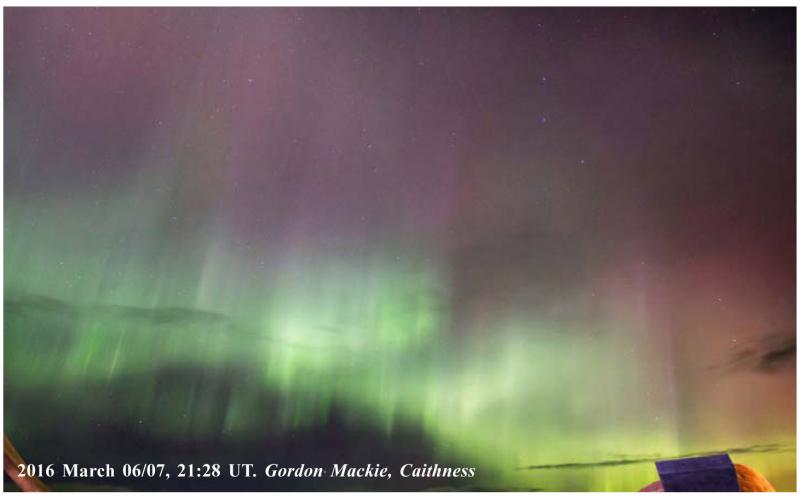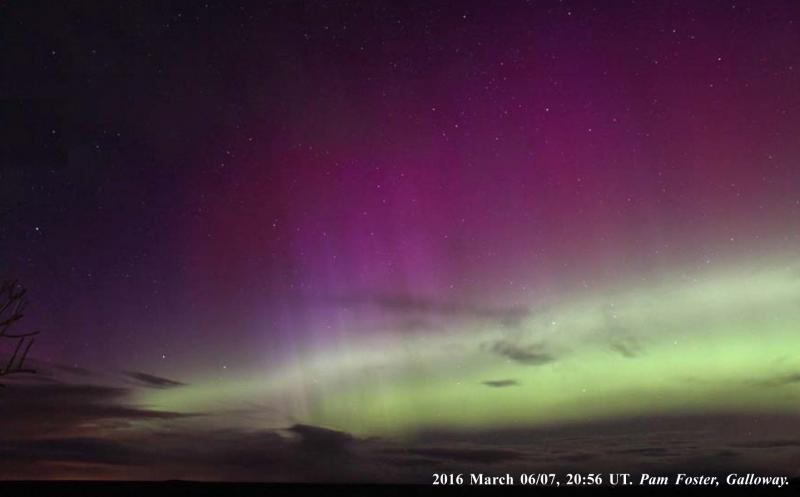Aurora Section notes
2016 May 22
 Solar activity is rapidly declining in terms of active areas, flares and CMEs (Coronal Mass Ejections) and there has been very little geomagnetic disturbance caused by this route since the beginning of 2016. However, in keeping with the declining solar cycle, coronal holes, often supplemented by a southerly Bz magnetic component have allowed high speed solar streams to interact with Earth’s magnetic field and have more recently provided us with quite good aurora displays, at least one being seen from more southerly latitudes.
Solar activity is rapidly declining in terms of active areas, flares and CMEs (Coronal Mass Ejections) and there has been very little geomagnetic disturbance caused by this route since the beginning of 2016. However, in keeping with the declining solar cycle, coronal holes, often supplemented by a southerly Bz magnetic component have allowed high speed solar streams to interact with Earth’s magnetic field and have more recently provided us with quite good aurora displays, at least one being seen from more southerly latitudes.
During the descent from solar maximum when coronal holes are the driving force in the solar wind, the Kp values do not always reflect the reported sightings of aurora. A good going southerly Bz can enhance a moderate Kp and this may spark visual aurora at more northerly latitudes. However, it is usually necessary to have a reasonably high Kp value to hope to see aurora from southerly latitudes.
Aurora 2016 January-April
In keeping with the low solar activity there were only a few auroral sightings reported during January and February. Auroral activity recovered in March with a widely seen active display on 06/07. (All times are UT unless otherwise noted).
Jan 11/12, Aberdeenshire, 22:15-22:30. Faint green glow to 5°. (SB)
Jan 19/20, Glen Ullin, North Dakota, 03:00-06:00 CDT. Homogeneous arc then rays. Radio aurora on Jan 20. (JB) (FV)
Feb 05/06, Caithness, 22:00. Faint aurora. (GM)
Feb 12/13, Caithness, 20:15-22:50. Faint glow brightening. (GM)
Feb 16/17, Dundee, 23:00. Auroral glow. Radio aurora on Feb 16. (NSB) (FV)
Feb 17/18, Thurso & Elgin, 20:45-00:45. Green arc and rayed bands to 30°. (GM, AT)
Mar 01/02, Tarbatness, 23:00-00:00. Arc and rayed band to 10°. (DB)
Mar 06/07, Edinburgh, Fife, Angus, Tarbatness, Caithness, Perthshire, Aberdeenshire, Cromarty, Moray, Wales, Yorkshire, Stoke-on-Trent, Oxfordshire, North Dakota. 19:30-04:30. Complex aurora developing from faint arcs and bands to a bright colourful display showing corona (DG, KK, FV, TC, GY, JN, DB, RT, JG, GM, KB, AT, SB, JB, PF, JM, JF, AH, TH, JBa, AC, DP, MS)
Mar 07/08, Aberdeenshire, Cromarty, Thurso, Elgin. 20:00-23:30. Less active than the previous night with reports varying from a faint glow to a double arc and rayed band. (JM, SB, GM, AT)
Mar 09/10, Caithness. 20:30-00:00. Low but fairly active display. (GM)
Mar 11, Glen Ullin, North Dakota. 03:00-04:00 CDT. Glow to 6°. (JB)
Mar 14/15, Caithness, Cromarty, Tarbatness, Aberdeenshire. 20:30-02:30. Green arc to 15°. Rayed band with red tipped rays. (GM, JM, DB, SB)
Apr 07/08, Dundee, Tarbatness, Aberdeenshire, Alness. 21:00-01:45. Multiple rayed bands to 40°. Purple rays but not very bright. (KK, DB, SB, JF)
Observers: SB: S Brantingham; JB: J Brausch; GM: G Mackie; NSB: N Skully Brooks; DB: D Buczynski; DG: D Gavine; KK: K Kennedy; FV: F Vincent; TC: T Cook; GY: G Young; JN: J Noble; RT: R Taylor; JG: J Gilchrist; KB: K Boyle; AT: A Tough; PF: P Foster; JM: J MacKintosh; JF: J Fraser; AH: A Heenan; TH: T Hayes; JBa: J Barber; AC: A Clitherow; DP: D Paterson; MS: M Spicer.
As the Sun becomes less active following solar maximum around the beginning of 2014 we are, naturally, less likely to see so many auroral displays as there have been in the past two years. My feeling is that there have been fewer big displays during cycle 24, especially in the number which have been seen at more southerly latitudes. However, it is still worth keeping an eye on the data provided by websites such as www.spaceweather.com or www.solarham.net as flares, CMEs and high speed solar streams from coronal holes will almost certainly continue to occur at times and these may produce good auroral displays.
With declining auroral displays and longer days interest will be maintained throughout the summer months by the appearance of noctilucent clouds. These have been regularly appearing for the first time in the northern hemisphere during the last two weeks of May and are likely to continue into early or mid-August.
Ken Kennedy, Director
| The British Astronomical Association supports amateur astronomers around the UK and the rest of the world. Find out more about the BAA or join us. |
